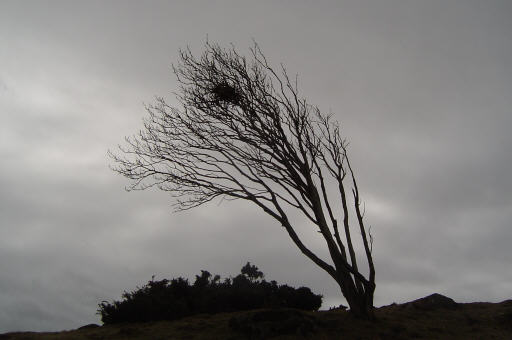|
Selecting a Site for a Wind Turbine

Wind Conditions
Looking at nature can be an excellent way to find a good site to install a wind farm. A tilted tree can for example indicates the prevailing wind direction (see
picture above). Erosion on the coastline is also a good clue. Meteorology data collected for over 30 years is probably the best way to choose a site, but these data are rarely collected directly at the desired site, and then there are many reasons to be careful when using meteorology data. The presence of other wind turbines in the area can be an excellent guide to local wind conditions thanks to their production results.
Look for a View
As we saw before, a wide and open view in the prevailing wind direction is preferable for the energy production of a wind turbine. Therefore, it is better to avoid every obstacle or roughness in this direction. A rounded hill is generally the best to place the turbines, because wind speeds can be increased thanks to the hill effect.
Grid Connection
Large wind turbines have to be connected to the electrical grid. It is therefore essential to be reasonably close to a 10-30 kilovolt power line to avoid prohibitive connection costs (costs to extend the electrical grid until the turbine).
Grid Reinforcement
The electrical grid near the wind turbine must be able to receive the electricity produced by the turbine. In the case of many turbines connected to the grid, the grid may need reinforcement with a larger cable and a connection close to a higher voltage transformer station.
Soil Conditions
Obviously, soil conditions must be considered when dealing the foundations of the turbines. It is also essential to take into account the construction of a road to reach the site with heavy trucks.
Drawbacks in Using Meteorology Data
It is important to realise that available meteorology data have been measured for weather predictions or aviation and not for the measurement of wind speeds itself. These measurements are therefore less accurate than necessary for the study of a potential site for wind turbines. Complementary
measurements must generally be made to determine the real wind speeds on the desired site. Nevertheless, meteorology data can give a good first idea of the wind conditions on the site.
< back | next:
>
|